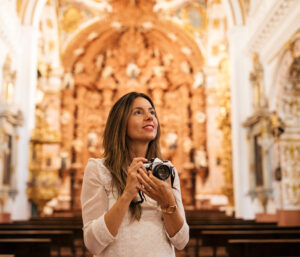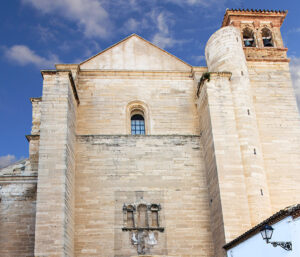On the exterior of this church we find a simple façade in the mannerist style, whose most notable element is its doorway comprising a semicircular arch with columns and where the Carmelite arms appear centrally and, at one end, the so-called Gallo Tower.

The church floor plan generally follows that of the Moorish church in Granada, a single nave, main chapel and side chapels, each one completely separate. Further, the nave of the Soledad Brotherhood was added in the 18th Century. Of great interest is the Mudejar craftsmanship which covers the whole nave and which was completed in 1614. It is completely decorated with interlaced patterns which can be seen interrupted by pineapple-style Mozarab vaulting.
The main chapel is arranged in the form of three enormous altarpieces amongst which we can especially highlight the centre one, built prior to 1747 and whose excellence lies in its baroque style and the beauty of its natural wood colour, without gold additions. The complex column decoration is to be noted, cornices, niches and more than 50 images, which represent one of the most interesting examples of an 18th Century baroque altarpiece work in Andalusia.

This enormous altarpiece was conceived as a Carmelite hymn in which the saints connected to the Order are seen together with a gathering of young angels playing musical instruments and holding signs or garlands, or simply holding hands in graceful poses and which appear to be touching palms. It seems surprising to think that this whole work of baroque art is only a frame to the main area which contains the image of the Virgin of the Carmen and her child.
The two lateral altarpieces of the main chapel, despite being finished in gold and polychromy, are believed to be somewhat more recent than the main one.
Contact:
Address: Plaza del Carmen, Antequera, Málaga
Schedule:
Tuesday to Friday: 11:00 h to 13:30 h / 16:30 h to 18:00 h
Saturday and Sunday: 11:00 h to 14:00 h
Phone: 952739662
